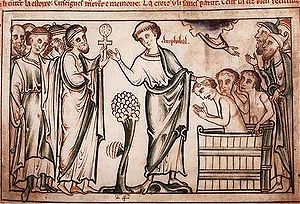Amphibalus
| Saint Amphibalus | |
|---|---|

Saint Amphibalus baptizing converts
|
|
| Martyr | |
| Born | unknown Isca (Caerleon) |
| Died | 25 June 304 Verulamium (St Albans), Hertfordshire |
| Venerated in |
Roman Catholic Church Eastern Orthodox Church |
| Major shrine | St Albans Cathedral, Hertfordshire (reconstructed medieval shrine) |
| Feast | 25 June (or 24 June) [1] |
| Attributes | Priest with cloak |
| Patronage | The Christian persecuted |
| Controversy | 'Amphibalus' is almost certainly not his real name; many of the major details of his life may be medieval embellishments |
Saint Amphibalus is a venerated early Christian priest said to have converted Saint Alban to Christianity. He occupied a place in British hagiography almost as revered as Saint Alban himself. According to many hagiographical accounts, including those of Gildas, Bede, Geoffrey of Monmouth, and Matthew of Paris, Amphibalus was a Roman Christian fleeing religious persecution under Emperor Diocletian. Saint Amphibalus was offered shelter by Saint Alban in the Roman city of Verulamium, in modern-day England. Saint Alban was so impressed with the priest's faith and teaching that Alban began to emulate him in worship and eventually became a Christian himself. When Roman soldiers came to seize St. Amphibalus, Alban put on Amphibalus' robes and was punished in his place. According to Matthew Paris, after St. Alban's martyrdom, the Romans eventually caught and martyred Amphibalus too.
Gildas (c. 570), Bede (c. 730) and the three texts of St Alban's Passio, going back as far as the 5th century, do not name Saint Amphibalus in their accounts of Saint Alban. They refer to Amphibalus not as a saint but simply as a priest and do not report his martyrdom. Amphibalus gained his name and title when Geoffrey of Monmouth wrote his History of the Kings of Britain in the 12th century. It is possible that Geoffrey had been repeating a name for the priest that had come into common usage in his time. It is also possible that Geoffrey of Monmouth misunderstood the Latin word used for the cloak, amphiboles, which was worn by Saint Alban.
Wilhelm Levison noted that the story of the name, which goes back to a 5th-century Passio Albani, is composed of borrowings from other lives of saints and it has, in his words, “no place in the ranks of Acta martyrum sincera; it is a legendary tale....”
Geoffrey repeated the story of Alban's martyrdom as given by Bede in his famous Historia Regum Britanniae (of c. 1136), with the addition of the name of the confessor he shelters, Amphibalus. He recounts a church of Amphibalus at Winchester where King Constantine consigned his son, Constans, to become a monk and where another, later, Constantine killed one of the sons of Mordred. Geoffrey may have gotten the name from Gildas, who describes his contemporary, Constantine, King of Dumnonia, as having dressed in the amphibalo, or 'cloak', of an abbot to murder two royal youths in a church. This could also be the inspiration for Geoffrey's story about the murder of the son of Mordred, and his association of Amphibalus's church with kings called Constantine. How, or why the story about Alban became connected to the story of king Constantine remains somewhat mysterious but might be an effect of Geoffrey's enterprising imagination, and confusion of sources.
...
Wikipedia
